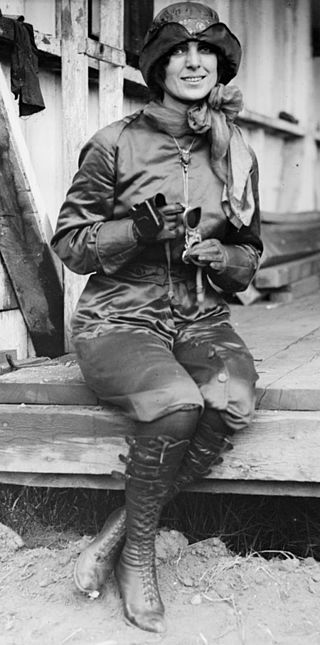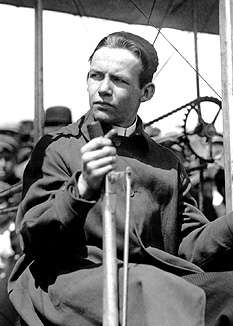Weldon B. Cooke | |
|---|---|
 Weldon Cooke, 1913 | |
| Born | 28 June 1884 |
| Died | September 16, 1914 (aged 30) |
Weldon Bagster Cooke (28 June 1884 - September 16, 1914) was a pioneer aviator. [1] [2]
Weldon B. Cooke | |
|---|---|
 Weldon Cooke, 1913 | |
| Born | 28 June 1884 |
| Died | September 16, 1914 (aged 30) |
Weldon Bagster Cooke (28 June 1884 - September 16, 1914) was a pioneer aviator. [1] [2]
He was born on June 28, 1884, in Oakland, California, to Ada L. and William H. Cooke. [3] Cooke grew up in Lockeford, California. Cooke's grandfather, Dr. Dean Jewett Locke, was the founder of the town of Lockeford. [4] Cooke attended the University of California where he graduated from the California School of Mechanical Arts and the College of Electrical Engineering. [5] In 1910, Cooke was racing cars and living in Oakland. [4]
In 1910, Cooke built and flew a Montgomery-type glider. In 1911, barge captain Lan Maupin and shipyard owner Bernard Lanteri constructed a biplane of their design in Pittsburg, California, that they named 'Black Diamond' after the nearby coal mines. [6] In June 1911 Maupin and Lanteri took a few test hops in their aircraft and decided they needed a professional pilot and hired Cooke, even though Cooke had never flown a powered aircraft. [5] Throughout the summer of 1911,Cooke practiced in the Black Diamond several times a day and made his exhibition flying debut at the Walnut Creek Grape Festival on October 6,7 1911. [6] On 19 December 1911 Cooke was the first person to overfly Mount Tamalpais in Marin County, California, in the Black Diamond. The flight ended in Mill Valley, California, on route to Oakland after an engine failure and glide to landing from 2000 ft of altitude. [5]
In early 1912, Cooke passed his test for his pilot's license, which was presented to him by Oakland Mayor Frank K. Mott on Jan. 13, 1912. [7] He received Aero Club of America's pilot license # 95, making him the second licensed pilot in California. [8] [9]

Cooke's Black Diamond exhibition flying culminated in its appearance in the January 1912 Los Angeles International air meet at Dominguez Field. Cooke's flying was outstanding, setting the meet record for endurance and altitude, winning $7,400 in prizes. In 1911 and 1912, including the Los Angeles prize money, Cooke's flying earned Maupin and Lanteri's now named 'Diamond Airplane Co.', a total of $14,800. The Los Angeles meet was the last flight of the Black Diamond. The Black Diamond was disassembled and put into storage and, in 1948, the Maupin family donated it to the Smithsonian. In 1998, it was offered to the Hiller Aviation Museum where it was restored and put on display. [7] [10]
At an exhibition on December 31, 1911 – January 1, 1912, in Santa Rosa, California, Cooke took a test flight in a biplane that had been constructed by Fred J. Wiseman that Wiseman had used for the world's first airmail flight from Petaluma, California, to Santa Rosa. [9] After the Los Angeles meet, Cooke no longer had an aircraft to fly, so he arranged to purchase the Wiseman biplane and had it crated up and sent to Emeryville, California, for an exhibition where he was to race Lincoln Beachy. Compared to Beachy's aircraft, the Wiseman biplane was under powered and Beachy beat him easily in all five days of the event. [9] To improve the performance, Cooke replaced the 60 hp (45 kW) Hall-Scott A-2 with a 75 hp (56 kW) Roberts two-stroke motor. Cooke continued to modify this aircraft as he used it for exhibition flying across the United States during 1912. The modified aircraft became known as the Wiseman-Cooke biplane. This aircraft became the second Cooke piloted aircraft donated to the Smithsonian where it was restored and put on display at the National Postal Museum. [11] By late 1912, Cooke had arrived in Sandusky, Ohio, where he formed the Cooke Aeroplane Co. to build aircraft of his own design. The Roberts Motor Company let him use a portion of their facility to work on his aircraft. [8] [9]
When Cooke participated in the 1913 Great Lakes Reliability Cruise his address was listed as Sandusky, Ohio. [12]
In May 1914, Cooke was back in the San Francisco Bay Area where he was the pilot of Silas Christofferson's 'Aeromaid' flying boat. Christofferson tried to start an aerial ferry service between Oakland and San Francisco, but gave up after just a few flights. [13]
Cooke died on September 16, 1914, in an aircrash in Pueblo, Colorado. [1] [14]

The Royal Aero Club (RAeC) is the national co-ordinating body for air sport in the United Kingdom. It was founded in 1901 as the Aero Club of Great Britain, being granted the title of the "Royal Aero Club" in 1910.
This is a list of aviation-related events from 1911:

This is a list of aviation-related events from 1912:

Harriet Quimby was an American pioneering aviator, journalist, and film screenwriter. In 1911, she became the first woman in the United States to receive a pilot's license and in 1912 the first woman to fly across the English Channel. Although Quimby died at the age of 37 in a flying accident, she strongly influenced the role of women in aviation.

Antony Habersack Jannus, more familiarly known as Tony Jannus, was an early American pilot whose aerial exploits were widely publicized in aviation's pre-World War I period. He flew the first airplane from which a parachute jump was made, in 1912. Jannus was also the first airline pilot, having pioneered the inaugural flight of the St. Petersburg–Tampa Airboat Line on January 1, 1914, the first scheduled commercial airline flight in the world using heavier-than-air aircraft. The Tony Jannus Award, created to perpetuate his legacy, recognizes outstanding individual achievement in the scheduled commercial aviation industry and is conferred annually by the Tony Jannus Distinguished Aviation Society founded in Tampa, Florida, in 1963.

Lincoln Beachey was a pioneer American aviator and barnstormer. He became famous and wealthy from flying exhibitions, staging aerial stunts, helping invent aerobatics, and setting aviation records.

Calbraith Perry Rodgers was an American aviation pioneer. He made the first transcontinental airplane flight across the U.S. from September 17, 1911, to November 5, 1911, with dozens of stops, both intentional and accidental. The feat made him a national celebrity, but he was killed in a crash a few months later at an exhibition in California.

Thomas Scott Baldwin was a pioneer balloonist and U.S. Army major during World War I. He was the first American to descend from a balloon by parachute.

Charles Francis Walsh was an American pioneer aviator who died in a crash in Trenton, New Jersey.

Isidore Auguste Marie Louis Paulhan, was a French aviator. He is known for winning the first Daily Mail aviation prize for the first flight between London and Manchester in 1910.

The Wright Exhibition Team was a group of early aviators trained by the Wright brothers at Wright Flying School in Montgomery, Alabama in March 1910.

Cecil Malcolm Peoli was an American aviator. He was, at the time of his death, the youngest professional aviator in the world.

Feng Ru, also known as Fung Joe Guey, was a pioneering Chinese aviator and aircraft designer.

Thomas W. Benoist was an American aviator and aircraft manufacturer. In an aviation career of only ten years, he formed the world's first aircraft parts distribution company, established one of the leading early American aircraft manufacturing companies and a successful flying school, and from January to April 1914 operated the world's first scheduled airline.

Farnum Thayer Fish was an early American airplane pilot known as the "Boy Aviator". He was, at the age of 15, the "youngest licensed aviator in the world".

Helen Hodge Harris (1892-1967) was among the first women to earn a pilot's license. She was therefore one of the few women among the Early Birds of Aviation. In addition she became a proponent of flight safety. She later became supervisor of a machine shop.

The Cooke 1913 Tractor Biplane was an experimental tandem biplane aircraft built by the Cooke Aeroplane Company in 1913.

Silas G. Christofferson was an American aviator. He was the brother of Harry Christofferson, a fellow Early Bird, and the husband of aviator and X-ray technician Edna Christofferson.
Ivan Rhuele "Van" Gates was an American aviator and entrepreneur. While a member of the San Francisco Police Department, he is credited with being the first to transport a prisoner by air. He founded or co-founded the barnstorming Gates Flying Circus, which attained much success and fame in the 1920s. Later, he and designer Charles Healy Day established the Gates-Day Aircraft Company, subsequently renamed the New Standard Aircraft Company, to design and manufacture airplanes.

Dave Dashaway was a series of juvenile aviation novels written for the Stratemeyer Syndicate by Weldon J. Cobb, using the pseudonym of Roy Rockwood. The series was published by Cupples & Leon from 1913 to 1915. The hardback books had a picture printed onto the front cover, plus a black and white frontispiece illustration.